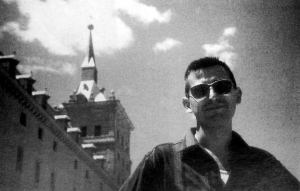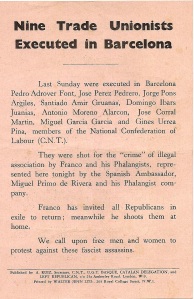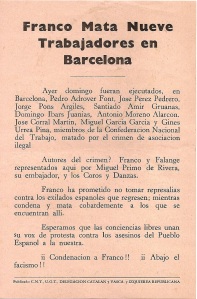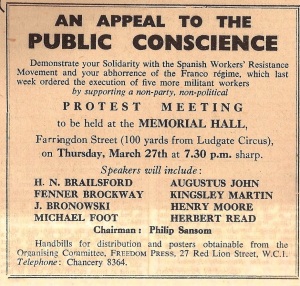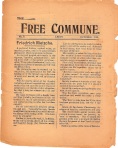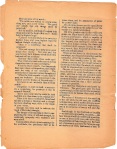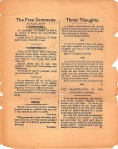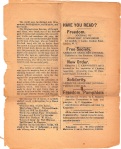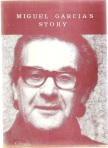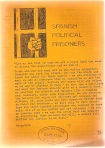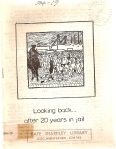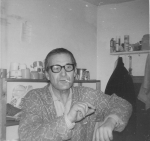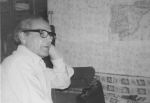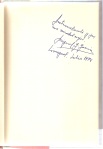Anarchist resistance to World War One in 1914 and 1915, within the combatant counties and elsewhere, took many forms. Sometimes it was just the act of holding a meeting, sometimes managing the publication of a clandestine newspaper or pamphlet. Strikes were instigated or supported and safe zones created for deserters and, if possible, their families. Sometimes it was a small act of internationalism such as when Jewish anarchists in London’s East End, working with German and French anarchists, created soup kitchens to feed German workers who found themselves unemployed after war was declared. At other times anarchist resistance took place in umbrella anti-War organizations, while elsewhere it was simply an individual holding on to the idea of anarchist internationalism against the constant pressure to be patriotic. Whatever action was taken or, for that matter, whatever thought processes were refined or retained, it was often solitary and dangerous work. This has meant that many small acts of contestation and defiance may never become known to us- but that doesn’t mean because they weren’t written about they didn’t exist. We do know that the collapse of unity in regard to anarchist resistance to the War was alarming and confusing. But within the chaos that ensued in our movement, some anarchists held their ground and fought back against the smothering tide of patriotism and nationalism. Here I want to discuss one initiative that fought back and place it in some kind of context.
View the scan of the International Anarchist Manifesto on the War
The International Anarchist Manifesto on the War was published in London, in early February 1915 and signed by 37 anarchists. It was published prominently in the anarchist press and appeared in the March 1915 Freedom, the March 1915 Spanish language paper Cultura Obrera (New York), the March 1915 Italian paper Volonta and the May 1915 issue of Mother Earth (New York) as well as numerous other papers. A four-page English language version also appeared as a leaflet in London during February, quite possibly printed by Freedom Press. It is worth remembering that by February 1915 it was obvious that the War wasn’t going to be over as quickly as had been fervently believed in its early days. Seven months had passed and casualty lists were growing at a frightening rate. The War was a stain growing wider and wider, and the space for critical thought and opposition, especially in the combatant countries, was becoming narrower and narrower, if there was any space left at all.
Although supposedly aimed at the wider populace to inform them of the anarchist position with regard to the War, in fact the Manifesto was primarily targeted at anarchists and dealt with the massive challenge to anarchists and anarchism the War created. Splits and disagreements about what anarchists should do about the War caused substantial damage both to the ability of anarchists to function and to some comrades understanding of anarchism. The most prominent example of this split, for historians anyway, is Peter Kropotkin who had privately been in favour of anarchists intervening in the War on the side of France and her Allies for some time. On 29 July 1914 he had written to the Russian anarchist Marie Goldsmith, then living in Paris, stating it was essential to “defend Paris and the post-revolutionary civilization of France from the German Huns.” Tom Keell’s (who was then editor of Freedom) account of the tense meeting between himself, Alfred Marsh and Kropotkin in London during August 1914 offers a further example of Kropotkin’s firm and unyielding interventionist beliefs. So, for some anarchists, the public evidence of his position, which appeared in the October 1914 Freedom with his article “An Open Letter To Professor Steffen” came as no surprise. For many others it came as a bolt from the blue as he argued that “it was the duty of everyone who cherishes the ideals of human progress, and especially those that were inscribed by the European proletarians on the banner of the International Working Man’s Association…to crush down the invasion of the Germans into Western Europe”. In the November 1914 Freedom others, including Jean Grave, who had been editor of Les Temps Nouveaux until it ceased publishing in 1914, Varlaam Cherkesov a member of the Freedom Group, and Belgian anarchist Frans Verbelen, wrote in support of Kropotkin with Grave suggesting that once German militarism had been crushed “the autonomy of the German people will be respected.” The November Freedom did print critiques of this interventionist position and apparent lines were drawn. These published debates help historians immensely, but I am not sure that they offer us a complete understanding of what happened amongst anarchists and their communities.
As the relevant issues of Freedom were distributed in England, Europe, and elsewhere one can imagine the confusion and consternation they caused in anarchist circles. What might be worth remembering is that it wasn’t just Kropotkin’s intellectual arguments for anarchist intervention in the war that hurt those who disagreed with his position. There was something else, equally profound and troubling for many of them. When anarchists spoke about Kropotkin (and quite a few in Europe and America had either met him, or knew someone who had) he was equally revered as a person as he was an anarchist theorist. He was “Our Peter”. We can see this trait in the December 1912 Mother Earth which celebrated Kropotkin’s 70th birthday. For Hippolyte Havel, Kropotkin was “the most beloved comrade in the anarchist movement”. Charles Malato wrote “With him the same pure flame illuminates the mind, warms the heart and guides the conscience” and F. Domela Nieuwenhuis explained that Kropotkin’s “profound knowledge, unexcelled integrity and high idealism have found appreciation even among his opponents”. The shock of discovering Kropotkin’s views about the War was, for some anarchists who disagreed with him, the shock similar to being betrayed by a close friend–someone who you thought you knew and who you often looked up to.
We would be clearly wrong, then, to ignore the substantial effect Kropotkin had with his call for anarchist intervention in the War. We would be equally wrong in seeing anarchists as simply reading his articles and agreeing with his views. There is enough evidence to suggest that quite a few anarchists had intuitively adopted an interventionist stance with regard to the War independent of Kropotkin and his ideas—even if their intervention was on the opposite side to his. In America, Michael Cohn, a close friend of Alexander Berkman and Emma Goldman and financial supporter of Mother Earth, had declared for Germany in the Freie Arbeiter Stimme in late 1914, arguing that defeat of Russia would mean greater safety for the Jewish population there. I do want to suggest though that these published sources on their own do not account for the considerable number of anarchists who arrived at an interventionist position under their own steam. To engage in the war either against Germany or to protect one’s country appeared to make sense to them without the aid of the writings of Kropotkin, or any other anarchist. For many their decision-making may well have been as much intuitive as anything else. It just felt right. We also have to accept that we don’t really know how many anarchists took neither side, changed their minds more than once or struggled to fit their anarchist beliefs into the world they suddenly found themselves in. I think that there were more of them than we have recognized.
If we do wish to read the Manifesto as a reply to Kropotkin and other anarchist interventionists, and see it as a collective standing of ground with regard to- accepted anarchist positions about war, colonialism, and militarism, we should also read it, then, as an attempt to deal with the confused and contradictory emotions that the War had unleashed in the anarchist world—and not just because Kropotkin wrote a few articles. If the War brought forth highly charged feelings everywhere, then anarchists certainly were not immune to them. Comrades of long standing, who had been through brutal and challenging times together argued bitterly with each other about the War. The London Freedom Group split apart for instance and there was a sense of emotional loss, of friendships broken, apparently forever; the certainty and comfort that comradeship provided was fractured. Within the communities where they lived and worked, anarchists saw young men they had grown up with disappear into the trenches. They saw the telegrams with their tragic news delivered to doors of their neighbours. Sometimes the War struck very close to home—Iacov Kaplan, the England-based Jewish anarchist editor and orator lost his eighteen-year-old son, Fred, in the conflict, and his wife to madness as a result of her son’s death. Other anarchists also lost family members. Communications between groups, individuals and other countries broke down as newspapers were suppressed and disappeared and letters were intercepted or never delivered. Some comrades went underground. It was a disheartening time and the movement was riddled with confusion, rumor, and suspicion. Consequently we have to be careful that we don’t underestimate this sense of confusion and isolation among anarchists that was rife, not only within the combatant countries, but elsewhere as well.
Certainly the signatories of the Manifesto recognized this state of affairs and attempted to address it. They also, of course, attempted to deal with the pressing intellectual problems that those anarchists supporting intervention in the War had posed. Much of this challenge focused on the idea of anti-militarism, a staple of anarchist belief. In an article in the November Freedom Kropotkin had argued that the idea of anti-militarism within anarchist circles had been “floating within generalities”. What would happen if the General Strike—a key tactic in ensuring that anti-militarism was a success—did not happen, or simply failed? The answer he wrote was obvious; the anarchist anti-militarist must give his support to the country that has been invaded. As the English anarchist W.C. Owen, writing in the November/ December Land and Liberty (Hayward, California) suggested, invasion or the threat of invasion for a country changes everything. Internationalist anti-militarism, in those circumstances, became impossible and redundant. Frans Verbelen, the Belgian anarchist (in 1913 a committed anti-militarist) whose country had been invaded wrote “reality blows away the most beautiful theories as a storm the sand in the desert.” Consequently anarchist practice appeared to be left with two choices; it could adapt to “reality” as the interventionists were trying to do, even if it meant losing some of the essence of what some anarchists felt anarchism was or, when faced with certain real circumstances, anarchism had to be put away for a while until these circumstances are dealt with and then, perhaps brought back when the time is right. Both arguments would be dismissed by the signatories of the Manifesto in favour of a unity of end, if not means.
It is somewhat unclear who actually authored the Manifesto. We can see traces of Malatesta, and if we look hard enough we might find a little taste of Berkman, although many of the ideas it articulated could be read in anarchist newspapers. It is quite likely that those around Freedom were central in the collection of its signatories through their network of correspondents and distributors. The bulk of the Manifesto’s signatories were based in London, New York, Holland and Switzerland. Some are well known to us now, others less so. There appear to be one or two transcription errors in the published version: A. Marquez may well have been the Portuguese anarchist Hilario Marques who helped publish the paper A Sementeira and whose work took him to London quite regularly (he had met both Kropotkin and Malatesta there in 1912) and Noel Panavich was the Italian anarchist Natale Parovich who was living in London at the time. Given the difficulties of communications between countries brought by the War, it is rather unlikely that the document was drafted and re-drafted by the signatories until final agreement was reached. This would have been a rather cumbersome and time-consuming process at a moment when speed was essential; it probably would have been impossible to do anyway. We also have to recognize that some who may have wanted to sign the Manifesto couldn’t. Rudolf Rocker, who had criticized the ideas expressed by Kropotkin and others in the October and November Arbeter Fraint, had been arrested in London in December 1914 and interned. Rudolf Grossman, in Austria, had been arrested twice in 1914 and spent the War under house arrest. Instead of seeing the signatories as a complete list of those anarchists who were opposed to involvement in the War, or those who were prominent in anarchist circles, we should probably see the list of signatories as those who could be quickly contacted, usually because they had in some way links with Freedom. One senses there was, though, a deliberately constructed internationalism with regard to the names on the document
The title of the Manifesto was deliberate. It’s an “International” document scorning the whole idea of nationalism and patriotism that the War had magnified and some anarchists had succumbed to. The Manifesto suggests that war is the inevitable cancer of capitalism and to choose sides between imperialistic and colonial states, as Kropotkin and others had argued anarchists should do, is irrational and nonsensical. They are all as bad as each other. The viciousness and militarism of Germany is matched by the “knout, gibbet, and Siberia” of Russia while the colonial cruelties of France are matched only by the brutalities of the British Empire. “None of the belligerents is entitled to invoke the name of civilization, or to declare itself in a state of legitimate defence” as interventionist anarchists might want us to believe. The different states at war, however we might describe their political character, are all organized for “the advantage of a privileged minority.” No nation’s culture is superior to another nation’s. (This idea that War could be fought because of a belief in some kind of cultural superiority—a sort of cultural legitimization of the slaughter—would be described as an “ insult to the human race” in the 21 April 1915 edition of the Spanish anarchist paper Tierra y Libertad)
The Manifesto argues that the role of anarchists “whatever may be the place or the situation in which they find themselves, is to continue to proclaim that there is but one war of liberation—the liberation of the slave from their masters!!!” Anarchists “need to weaken the state and cultivate the spirit of revolt among “peoples and armies”- an acknowledgement that some anarchists may have joined up and already be in the military. It goes on to address workers and soldiers, and in a Bakuninite flourish calls on “the outcasts” not to give up their arms until they “have settled accounts with their oppressors”. The war can lead to something wonderful. Out of this ugly carnage may come the creation of the anarchism we have so longed for if we continue to fight for our ideas.
The Manifesto, recognizing the emotional turmoil that anarchists may be going through, goes on to demand “No despondency”. Now is the time we must show people the “generosity, greatness and beauty of the anarchist ideal” This is not a defeat but the beginning of a possibility. A new world, the writers imply, is waiting. What the War presents is an opportunity and perhaps those anarchists who oppose it and those who are fighting in it still have much in common. Given the circumstances it is a brave call for unity. We may have distinct tactical differences but our aim is the same and the Manifesto offers no condemnation of those anarchists who joined the armed services and adopts no sense of moral superiority towards them. Instead it urges all anarchists to focus on the defeat of their oppressor at home, and abroad!! The Manifesto ends with a ringing definition of what the signatories understand anarchism to be: “social justice realized through the free organization of producers; war and militarism done away with for ever; and complete freedom won, by the abolition of the State and its organs of destruction”
We have, then, a delicately balanced document appealing to the reader’s intellect as well as their emotions as it calls for a coming together of anarchists to fight for liberation. It offers a generalist blueprint for the social revolution, and in doing so attempts to ease the intellectual and emotional confusion that the authors and signatories recognize in the anarchist movement around them. It is an impressive response to difficult circumstances within anarchism, taking cognizance of them while still urging anarchists to keep their eyes on their final aim.
In summary, we can see that the anarchists responsible for the Manifesto attempted to critique the interventionists position and rally what they felt was a confused and despondent movement—a movement ‘devitalized and confused by the war crisis” as Leonard Abbott wrote in December 1914. They also wanted to re-affirm the ability of pre-War anarchism to deal with the situation many anarchists found themselves as the War relentlessly progressed. Throughout the Manifesto, leading up to its passionate final paragraph, is the assertion of the relevance of the anarchism, that it’s final paragraph defines. Anarchism is not unable to deal with the challenges of the war. Nothing has changed. As anarchists they know where they want the world to go. Never has anarchism been more relevant as we fight for our alternative to the horror around us and, remarkably, never has anarchism’s realization been more possible.
The Manifesto is also an attempt to re-assure and remind European comrades, that the anti-war anarchists were alive and active and remained consistent in their opposition towards the War and all it represented. At least three of the signatories were on the run from combatant countries. Eugene Edouard Boudot had escaped from France to England as he was on the list of agitators to be arrested (the so called “Carnet B”). In his absence he was sentenced to five years imprisonment for failing to answer the draft. He would return to France in 1922. Henry Combes was managing editor of Le Mouvement Anarchiste. Charged with organizing anti-militarist campaigns he too had fled to England. Paul Schreyer was the editor of the weekly paper Kampf (Struggle) and fled from Germany to Switzerland in 1914. This was their chance to let comrades know they were both safe and resolute and that they had international anarchist support for their ideas. At a time when nothing seemed possible and confusion was everywhere, for a moment in time, the Manifesto offered some stability in terms of anarchist principles and anarchist resistance to the War.
Of course it wasn’t that simple or straightforward. That stability was fleeting and a little illusory. We should bear in mind that Harry Kelly had signed the Manifesto even though he was in sympathy with the interventionist position and F. Domela Nieuwenhuis would probably not have been sympathetic to the call for armed revolution the Manifesto makes. One wonders if, for some signatories, the need to come together against intervention in the War was the most important task of all at that moment in time. That said, even a signatory could change their mind; by 1918 Saul Yanovsky was speaking in favour of intervention, feeling that the new Russia had more chance of surviving with an Allied victory rather than a German one.
Finally we should mention that a large number of the signatories were from or living in two countries not yet in the war, but quite possibly not far away from entering the conflict, Italian anarchists living in London and elsewhere were prominent as signatories while anarchists from various countries but now living in the USA were also well represented among those who had put their names to the Manifesto. It seems very likely that both groups of comrades saw the Manifesto as part of the constant anti-militarist struggle they were engaged in. It suggested that they were not alone and organization against the War was taking place everywhere. If the Manifesto did urge a type of unity between anarchists, for those signatories engaged in the immediate anti-War struggle in these two countries there could be no question of accepting the involvement of their country into the conflict. That fight was still to be fought. For both sets of comrades the struggle would be exhausting and ultimately unsuccessful. Italy would enter the War three months after the publication of the Manifesto; America in April 1917. But that, as they say, is another story.
.



 Posted by jmoran
Posted by jmoran 